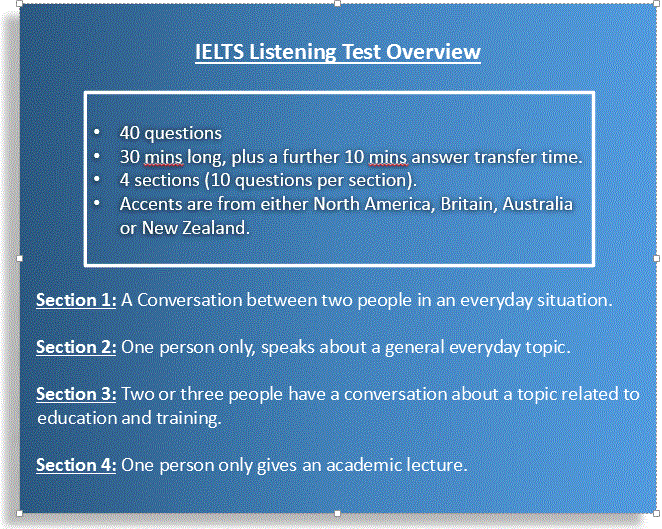(click image to enlarge)
IELTS Listening: Important Information
The IELTS Listening test has 4 sections of 10 questions and takes approximately 30 minutes, there is an additional 10 minutes for you to transfer your answers on to the answer sheet provided.
The speakers can have accents from either: North America, Britain, Australia or New Zealand. You will hear each recording only once and spelling is important when writing your answers.
Each of the four sections has a different type of recording, they are:
[stextbox id=”grey” color=”545454″ bcolor=”E0E0E0″ bgcolor=”FAFFAD” bgcolorto=”FCFFD9″ mleft=”5″ mright=”5″ mtop=”5″ mbottom=”5″ image=”null”]
Section 1 – A conversation in an everyday social context between two people, such as a telephone conversation between a travel agent and a customer booking a holiday.
Section 2 – A monologue on a topic relating to general social needs, for example, someone giving a speech about recycling in the community.
Section 3 – A conversation in an academic context between two or more people. This could be a university student discussing their essay with a tutor.
Section 4 – A lecture or talk (monologue) on a topic of general academic interest. It could be a University professor giving a lecture about a particular science topic.
[/stextbox]
What Types Of Questions Are In The IELTS Listening Test?
You will find a variety of different types of questions in the test. You can see examples of all of these in the free samples listed in the next section, however the main question types are:
[stextbox id=”grey” color=”545454″ bcolor=”E0E0E0″ bgcolor=”FAFFAD” bgcolorto=”FCFFD9″ mleft=”5″ mright=”5″ mtop=”5″ mbottom=”5″ image=”null”]
1. Multiple choice – Choose an answer A,B or C.
2. Matching – Match a list of items from the speaker to a list of options on the answer paper.
3. Plan/map/diagram labeling – add names/labels to parts of a visual.
4. Form/note/table/flow chart/summary completion – Fill in gaps in the script of the recording. Usually they will be the main ideas/points. This question type may also come in the form of a flow chart, notes, table or form.
5. Sentence completion – read sentences that give an overview of important information from either all of the listening text or from just one small part of it. Your task is to enter information in to a gap in sentences, using information that you have heard.
6. Short-answer questions – independently write a short answer based on information you have heard from the recording.
[/stextbox]
What Listening Skills Are Being Tested?
There are 5 different listening skills that are being tested. Knowing what these skill as and how they are used in the exam can help you practice more efficiently.
[stextbox id=”grey” color=”545454″ bcolor=”E0E0E0″ bgcolor=”FAFFAD” bgcolorto=”FCFFD9″ mleft=”5″ mright=”5″ mtop=”5″ mbottom=”5″ image=”null”]
Predicting: Using your knowledge of a topic and the situation to guess what speakers are talking about.
Identifying key words: You need to be able to identify the most important words in a sentence to understand its meaning. This is often done by listening for tone of voice and the intonation that a speaker uses.
Listening for specific information: Often we listen for one or more important pieces of information, such as a place name in a weather forecast or a number in a television advert. Being able to ignore unimportant information and focus on that specific information is an important skill.
The ability to listen to and identify synonyms and paraphrases for what you are looking for is also important. For example, a question might ask how many days will it rain for and the speaker might use the phrase ‘wet weather’ rather than rain.
Listening intensively: This skill is used when everything the speaker says is important. This could be when instructions are being explained such as when a salesman is explaining to you how to use the new I-pad you have just bought.
Identifying attitudes of speakers: This means working out what the speaker is actually thinking or feeling even though they might not say something directly.
For example, if someone says ‘isn’t that a bit expensive?’ they aren’t asking that question, they are really saying that they think that thing is expensive. Tone of voice and intonation play a role here.
[/stextbox]
There are 6 different question types, each one requiring a different listening skill. Each section can have a mixture of these task types.
This means that if you identify the question type you will know what listening skill they are testing and be better prepared to answer.
IELTS Listening Test Strategies
There are two areas you need to concentrate on to do well in your IELTS listening test.
Firstly, you need to be aware of the format of the test and how to do it effectively, discover good exam technique here and there are links to actual listening tests at the bottom of the page for you to try.
Once you have a good understanding of the exam format and exam techniques, the only thing left to improve is your listening skills. There are effective IELTS listening practice techniques provided here.
You can improve your technique quite quickly and this may improve you band score. However, if you keep taking the test and are getting ‘stuck’ at the same score, you need to focus on your overall listening skills.
Preparing early for your listening test and surrounding yourself with as much English language as possible is ideal, however the best thing is ‘active’ listening practice, where you actually have to do something with the information you are hearing. Again, these exercises will help.
Correct spelling is also critical in IELTS, as well as being able to understand a variety of accents, so make sure you practice with accents from the UK, Australia, New Zealand and North America as these are the only accents used in the test.
The video news sections here will help: CNN, 9News, One News and Telegraph News.
IELTS Listening Band Scores
Some listening tests are more difficult than others, because of this the IELTS examiners alter the grade band boundaries for each different test. However, the following band scores reflect the average and give a good indication of your band score.
[stextbox id=”grey” color=”545454″ bcolor=”E0E0E0″ bgcolor=”FAFFAD” bgcolorto=”FCFFD9″ mleft=”180″ mright=”180″ mtop=”5″ mbottom=”5″ image=”null”]
IELTS Listening Band Scores:
16-22 = Band 5
23-29 = Band 6
30-34 = Band 7
35-39 = Band 8
40/40 = Band 9
[/stextbox]
Have a look at the sample listening tests below for examples of all these different types of questions. The most important thing though is to read the instructions carefully AND follow them!
Free IELTS Listening Samples And Practice Tests
A full online version of the listening test from the British Council.
Another full test test to try here from IDP.
A selection of tests to try here provided by IELTS.org
Where To Next?
I hope you found this IELTS listening overview useful. you might like to read:



